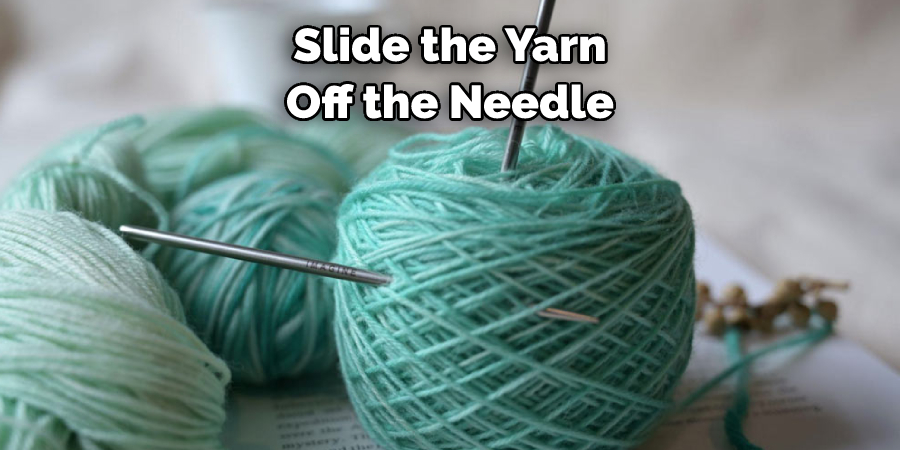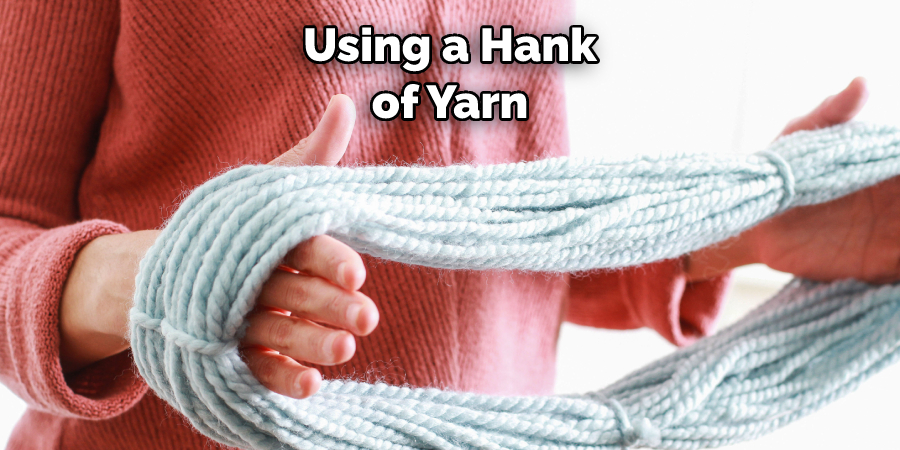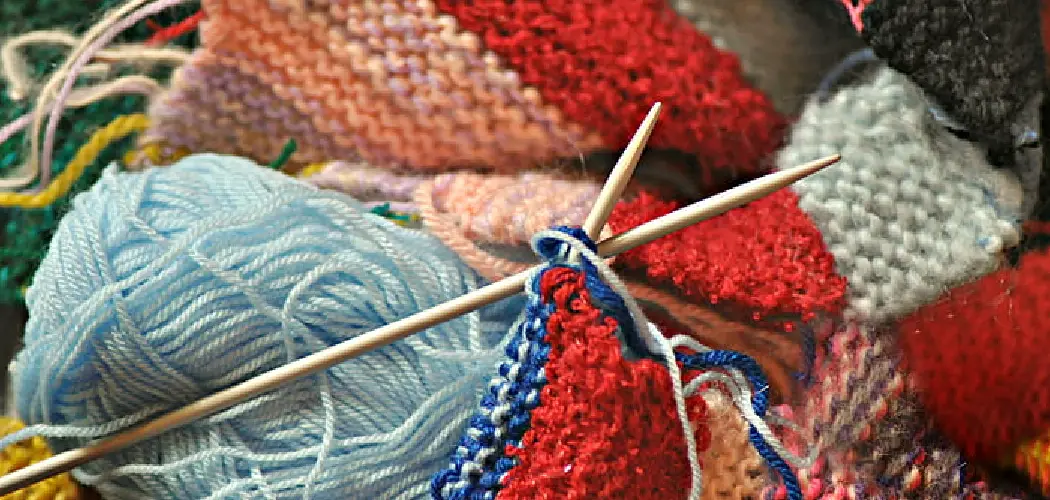Knitting is an enjoyable activity that can be done virtually anywhere. It’s a relaxing and creative hobby that can help you unwind after a stressful day. To get the most out of your knitting experience, it’s important to learn to hold knitting needles and yarn properly. Not only will this make the process easier and faster, but it will also help you create high-quality projects.

The advantages of knowing to hold knitting needles and yarn properly are numerous. Properly holding the knitting needles and yarn will allow you to knit faster and more efficiently and improve your accuracy when creating shapes, such as cables or lace patterns.
Additionally, it helps to greatly reduce the amount of stress placed on your hands, arms, and shoulders, allowing you to knit for longer periods of time with less fatigue. In this blog post, You will learn in detail how to hold knitting needles and yarn.
Step-by-Step Processes for How to Hold Knitting Needles and Yarn
Step 1: Inspect Your Yarn
Start by examining your yarn. Determine the type of yarn you have and the size of needles that are suitable for it. Once you’ve chosen the right yarn, gather all of your supplies in one place, such as scissors, measuring tape, knitting needles, stitch markers, and more.
Step 2: Preparing Your Needles
Hold one knitting needle in your dominant hand with the tip pointing away from you. With your other hand, grab the other end of the same needle and wrap the yarn around it twice, creating a loop. Pull the loop tight and pinch it between your fingers to keep it secure. Repeat this step with each of the other needles.
Step 3: Hold the Yarn
Once you’ve prepped your needles, it’s time to learn how to hold the yarn. If you’re right-handed, place the yarn in your left hand and wrap it around your pinkie and ring finger. With your index and middle fingers, pin the yarn firmly, creating tension. If you’re left-handed, wrap the yarn around your pinkie and ring the finger of your right hand instead.
Step 4: Hold Both Needles at Once
Now that you know how to hold the yarn, it’s time to learn how to hold both needles simultaneously. Place your dominant hand on top of the needle with the prepped loop and place your other hand underneath. Grip each needle firmly in your hands and maintain an even tension between them.
Step 5: Cast On Stitches
Once you know how to hold your needles and yarn, it’s time to learn how to cast on stitches. Start by looping the yarn around one needle as if you were wrapping a gift. Pull the other end of the yarn through this loop and pull it tight. This will create your first stitch.

Step 6: Knit a Stitch
To knit a stitch, insert the needle with the prepped loop into the first cast-on stitch. Wrap the yarn around this needle and pull it through, creating a new stitch. Pull the old stitch off of your other needle and repeat this process for each subsequent row.
Step 7: Purl a Stitch
To purl a stitch, hold the needle with the prepped loop in your dominant hand and place your other hand on top of it. Move the tip of this needle from front to back, wrap the yarn around it, and pull it through. This will create a new stitch and move the old one to the other needle.
Step 8: Increase a Stitch
To increase a stitch, simply insert your knitting needle into the same stitch twice and knit or purl as usual. As you do this, you’ll create two stitches on one needle instead of one. This will add extra width to whatever you’re knitting.
Step 9: Decrease a Stitch
To decrease a stitch, insert your needle into two stitches simultaneously and knit or purl them together as one. This will reduce the number of stitches on one needle and create a slanted edge.
Step 10: Cast Off Stitches
To cast off stitches, begin by knitting two stitches together. Pull the first stitch over the second and slip it off of your needle. Continue this process until your stitches are off your needles and you’ve completed your project.
Now that you know to hold knitting needles and yarn, you’re ready to start your next project. With a little practice and patience, you’ll be creating complex pieces of knitting in no time.

Tips for How to Hold Knitting Needles and Yarn
- Hold your knitting needles firmly, but don’t apply too much pressure as it can cause them to bend or break.
- Make sure you are always in control of the yarn and the needle while knitting; this will help reduce any potential risks of injuring yourself or someone else with a sharp needle or tangled yarn.
- Keep your fingers and hands away from the needle’s sharp point, as this could cause injury or, even worse, infection if you prick yourself with a dirty needle.
- When learning to knit, it’s important to ensure that you use the correct size needles for your project; using too large of a needle can make it difficult to maneuver the yarn, and too small of a needle can cause you to lose control of the project.
How Can You Avoid Splitting Your Stitches When Knitting?
- Start by using the correct size knitting needles for your project. Needles that are too small or too large can make it more difficult to achieve even tension when working with yarn and may cause the splitting of stitches.
- Make sure you grip your knitting needles well as you hold them in place under the yarn loop. Hold your needle tips in a relaxed grip, but make sure your fingers are not too loose.
- Slide the yarn off the needle and apply gentle tension as you work each stitch to ensure evenness and prevent the splitting of stitches.
- Take care to avoid overworking any one area of the fabric that could cause it to pucker, which can lead to split stitches.
- If you notice a stitch is beginning to split, try reworking it by unraveling it and starting again with a fresh loop around the needle.

Following these steps will help you avoid splitting your stitches when knitting and ensure that each stitch is perfectly even and secure.
How Can You Keep Your Yarn From Getting Tangled While Knitting?
Yarn that’s constantly getting tangled is one of the most frustrating parts of knitting. Luckily, there are some simple ways to make sure your yarn stays tangle-free while you knit. First, be sure to hold your knitting needles and yarn correctly. The best way to do this is with a relaxed grip on the needles.
You want to ensure you have enough tension on them to keep the yarn from slipping but not too much that it causes discomfort. The yarn should be wrapped around your index finger, or if you find that uncomfortable, you can use a yarn guide instead.
Next, gently pull the yarn off the ball as you knit. This helps to keep it from getting knotted up in the first place. If you are using a hank of yarn, make sure to wind it into a ball before beginning your project. This will ensure that there is no extra tension on the yarn as you knit, which can cause tangles and knots.
Finally, use a swift or a yarn bowl to keep your yarn untangled as you work. The swift holds the ball of yarn in place, so it doesn’t move around while you knit, and the yarn bowl helps keep loose ends from becoming tangled.

How Should You Store Your Knitting Needles and Yarn When Not in Use?
- When storing your knitting needles and yarn, ensure they are kept in a safe place, away from any areas that may be exposed to extreme temperatures or humidity.
- It is best to store them in a cool, dry place, such as an air-tight container or a drawer.
- Make sure there is no dust or dirt in the container or drawer, as this can affect the quality of your knitting needles and yarn.
- If you have wooden knitting needles, it is best to store them away from direct sunlight or any other sources of heat and humidity, as these could cause them to warp or crack over time.
- Yarn should also be stored in a cool, dry place away from direct sunlight and heat sources.
- You can also store your knitting needles and yarn in cloth bags or other breathable containers to help keep them safe from dust and dirt.
- To prevent the tangling of the yarn fibers, you should roll up the yarn into a ball before storing it away.
- Finally, make sure to label all of your containers and bags with the type of yarn or knitting needles so that you can easily find them when needed.
Following these steps can help ensure that your knitting needles and yarn are kept safe and secure for when you need it.
How Often Should You Replace or Repair Your Knitting Needles and Tools?
Your knitting pattern will usually give specific instructions on which types of needles and tools are best for each project. It’s important to use the right tools for every job, as improper tools can cause mistakes or damage your knitting needles and other materials. Check your pattern if you’re unsure what tool is needed.
Likewise, it’s important to replace or repair knitting needles and tools when they become outdated, worn out, damaged, or too blunt. Knitting needles can lose their sharpness over time and can snag on yarn if not replaced. Make sure all your tools are in good condition before starting any project.

Conclusion
One of the main disadvantages of holding knitting needles and yarn is that it can be difficult for beginners to learn. It takes some practice to get used to holding the needles and yarn correctly, as well as coordinating your movements in order to create even stitches. Additionally, the incorrect technique can lead to uneven stitches or dropped stitches.
So, now you have all the information you need to know about properly holding knitting needles and yarn. It’s really quite simple once you understand the basics. Remember that it is important to practice your technique regularly so that it becomes second nature when you are knitting.
With regular practice, you’ll soon be able to knit beautiful patterns easily. I hope this article has been beneficial for learning how to hold knitting needles and yarn. Make Sure the precautionary measures are followed chronologically.
You Can Check It Out to Fasten off Crochet

